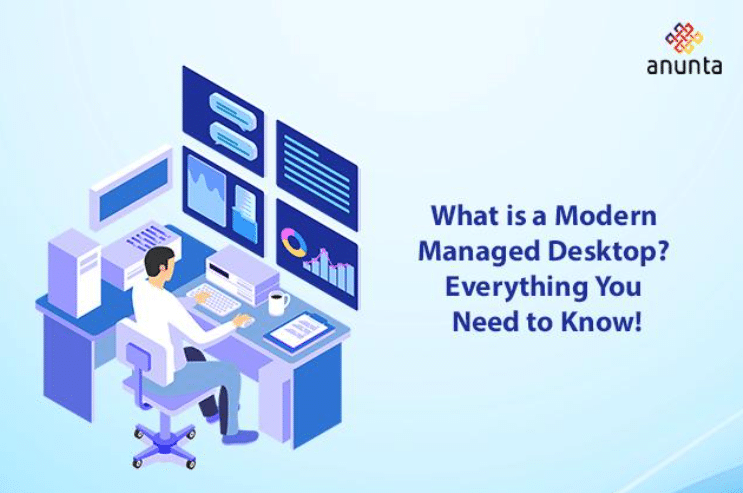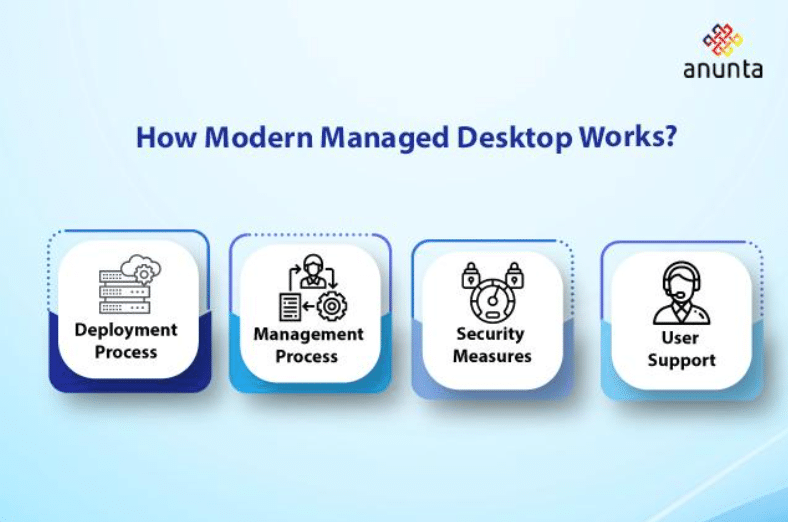
Desktop management is an important element for the operational success of the company. Organizations demand solutions that help them enhance productivity, fortify security, and streamline IT operations. To fulfil this demand of modern problems, there is a modern managed desktop that proavides cutting-edge service and framework to revolutionize the way organizations manage and secure their computing environments.
MMD integrates various advanced technologies to provide a seamless, secure, and up-to-date user experience. It leverages cloud-based solutions, automation, and sophisticated analytics to provide a comprehensive approach to desktop management.
Modern managed desktop is a service and framework that is designed to streamline and enhance the user experience, management, and security of the IT domains. The term’ modern desktop’ is defined as an interface in which the end-user can access the corporate network via domain or non-domain machines, virtualization, and cloud computing.
It offers a comprehensive suite of features to provide enhanced security and improve user experience. The features include advanced security measures with automated updates, data encryption, antivirus protection, and other robust features against cyber threats. There is also a cost-efficiency feature in MMD that ensures that companies do not spend huge amounts of money on securing their data. The scalability features allow businesses to adjust their resources and manage their business activities efficiently.
Modern managed desktop simplifies the automation of desktops and helps access company networks, apps, and other features through domain or non-domain sources. However, there is a complete process of how it leverages cloud-based technologies and leads to automation.

There is simplified provisioning, which is a deployment process that pre-configures devices before reaching the end user. This process helps to eliminate the need for IT administrators to set up each device manually. When the user gets their new device, they just have to connect the device to the Internet and log in with company credentials. The system automatically applies all the necessary settings, policies, and applications. In this deployment process, there is no downtime process, which thus helps increase productivity.
There is a centralized management system in which configuration and other managers are integrated to provide a single console for managing all the devices. There is also policy enforcement in which the IT administrators can define and enforce security policies to ensure their compliance with the organizational standards.
It is also a feature of modern managed desktops that the applications can be deployed and updated remotely by ensuring that the users have access to the latest tools and software without any hassles. If there are on-premises requirements, then there is a configuration manager that can perform robust management, including software distribution, inventory, and patch management.
Security has become an essential part of this world of technology. It is normal for every organization to protect its data, as well as that of its employees and consumers. So, an MMD understands this requirement and ensures that all the devices receive the latest security updates and patches automatically to reduce the vulnerabilities. There is integrated threat protection that helps detect and respond to potential threats in real-time. It also includes protection from advanced identity protection, threat analytics, and information protection. Device encryption, Multi-Factor Authentication (MFA), and Endpoint Protection (antivirus and anti-malware) are some of the main drivers behind the implementation of MMD.
Modern managed desktop empowers users as they can resolve common issues through self-service portals, and thus, it reduces the work and burden on IT support teams. Some automated troubleshooters detect the issue and resolve problems before they impact the end user. This feature ensures a smooth experience for the end user. If a support ticket is submitted by the user, then the IT support team can use it remotely to provide assistance and reduce downtime and disruptions.
MMD provides various benefits to unlock the full potential of the business using this technology. It ensures that there is automation of services with enhanced security features to allow companies to dedicate their precious time to other operational activities, and MMD performs the major management of technologies.
A modern managed desktop ensures that the device receives the latest security updates and patches automatically to reduce the end user’s vulnerabilities. It protects against the latest threats by consistently updating the latest security features and its updates without user intervention. The encryption in the MMD protects the data even if the device is stolen.
Content and its management are securely delivered all over the Internet. It ensures that the organization simplifies the infrastructure and reduces the cost and effort involved in maintaining the traditional management solution, which involves zero-touch provisioning, in which the devices are ready to be used out of the box, reducing the time and effort required for initial setup.
It is based on scalable infrastructure as it leverages cloud-based tools and thus helps in scalable management by accommodating the growing number of devices without much infrastructure investment.
The MMD uses integrated tools for facilitating collaboration and productivity. The end users can access these tools from anywhere and anytime, which enhances their flexibility and productivity. As integrated collaboration is easy in MMDs, it enables real-time communication, thus making it easier for teams to work together regardless of their physical location. There are also shared resources for increased collaboration and efficiency.
Automation of deployment, management, and all other updates reduces the workload of IT teams and provides them space to devote their time to other strategic things. These self-service portals and automated troubleshooting help to minimize the need for IT support, thus reducing the associated costs. There is also a system in MMD that the organizations have to pay only for those models that they are using, so this can reduce the upfront cost for the companies.
Modern managed desktop is considered a versatile solution that can be effectively used across various sectors to enhance security, productivity, and management efficiency. Corporations can make use of MMDs to streamline their IT management by providing centralized control over devices. It also enables seamless remote work capabilities and ensures compliance with security policies.
It can be used in the healthcare sector to protect sensitive patient data and enable technologies in the health sector. Hybrid learning environments are promoted with this technology, which benefits various segments of society.
Employees demand the latest technology in their work that can help them and increase their productivity. As there is a shift to remote work, there must be technologies that can make the work of employees easier. Modern managed desktop provides an opportunity to succeed and use the company device anywhere and anytime without compromising data and security.
A: MMD is a comprehensive service that helps organizations with seamless, secure, and efficient desktop management. It leverages cloud-based technologies, advanced analytics, and automation to ensure that the devices are up-to-date, safe, and ready for use with minimal IT interventions.
A: It enhances security updates through advanced threat protection and comprehensive data protection. There are uses of various platforms to protect such data, and it ensures that such data is accessible only by authorized users.
A: The technology simplifies device management as it provides a centralized management platform for the organization. This centralized platform helps the IT administrators to manage the devices, enforce security operations, deploy applications and monitor compliance through a single console.
A: It helps to increase productivity by providing users with seamless access to various applications and collaborations without any hassles. It ensures that the users have a consistent and familiar environment across the devices, which will reduce the learning time for the employees.
A: The autopilot feature in MMD plays a significant role as it simplifies the deployment and provisioning of new devices. The devices are pre-configured before they reach the employee, and once they receive it, the users can simply connect to the internet and log in with company credentials. The autopilot in the system will work on all the necessary settings, applications, policies, and other features, reducing the work of the IT administrators.
Research Review with Anunta’s CTO | Jan 14 | 12PM PST/3PM EST